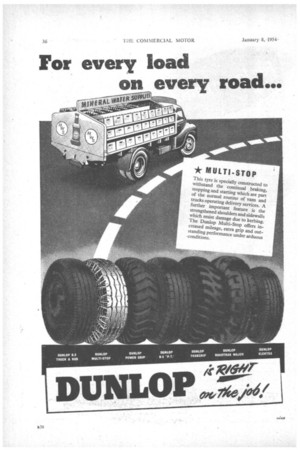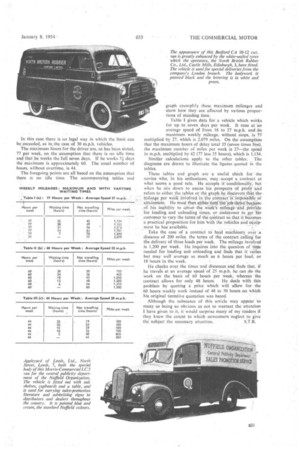For every load on every road.
Page 64

Page 65

If you've noticed an error in this article please click here to report it so we can fix it.
In this case there is 110 legal way in which the limit can bejexceeded, as in,the case of 30 M.p.h. vehicles.
The maximum hours for the driver are as has been stated, 77 per week, on the assumption that then: is no idle time anilthat.lie.works the full seven days. If he works 5h days the maximum is approximately 60. The usual number of hours, without overtime, is 44.
The foregoing points are all based on the assumption that there is no idle time. The accompanying tables and • graph exemplify these maximum mileages and show how they are affected by various proportions of standing time.
Table I gives data for a vehicle which works for up to. seven days per week. It runs at 'an average speed of from 16 to 27 m.p.h. and its maximum weekly mileage, without stops, :is. 77 multiplied by 27, which is 2,079 miles. On the assumption that the maximum hours of delay total 35 (seven times five), the maximum number of miles per week is 27—the speed in m.p.h. multiplied by 42 (77 less 35 hours), which is 1;13,4.
Similar calculations apply to the other tables. The diagrams are drawn to illustrate the figures quoted in the tables, These tables and graph • are • a useful check for'•the novice who, in his enthusiasm; may. accept a , contract at
what Seems a good rate. He accepts but when he sits down to assess his prospects of prat" and refers to either the tables or the graph he 'discovers th41.the Mileage per week iro!,-olVed in the contract is'impossit* of 014M-tient. He Must then Stht4ttri: the job dotsu because of his inability to cover •the •seek 's mileage and proVide for loading and unloading limes, or endeavour to get his ,customer to vary the terms of the contract so that it becomes a practical proposition for hinfwith the vehicles dnd:lerini'p
ment he has' available. ': .
Take the case of a contract to haul machinery over a distance of 200 miles the terms of the contract calling lor the delivery of three loads per week, The mileage involved is 1,200 per week. He inquires into the question of tneeded for loading and unloading and finds. that_ it vaites but may well average as much as 6 hours per load, or 18 hours in the week. t . , . He checks over the times and distances and finds that, if he travels at an average speed of 25 m.p.h. he: ean_do, the work on the basis of 60 hours per week, whereas the
contract allows for only 48 hours. He deals with .this problem by quoting a price which will allOw for -the 60 hours weekly work instead of 48 to 50 hours, on .Which his original tentative quotation was based.
Although the substance of this article may atipear to many as being so obvious as not to warrant the attention I have given to it, it would surprise Many of my readers if they knew the extent to which newcomers neglect to give the subject the necessary attention. S.T.R.




































































































